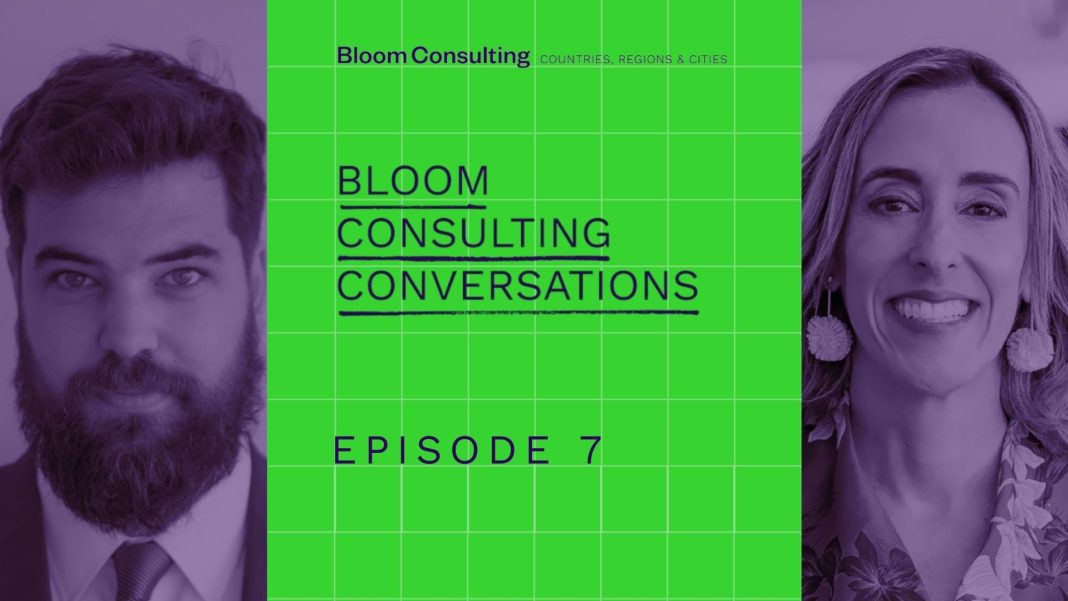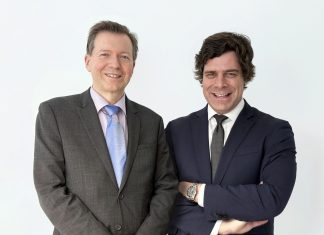Welcome to this special series of Bloom Consulting Conversations. Hosted by Clare Dewhurst, Director of City Nation Place, this series explores the world of Nation and City Branding, focusing on Bloom Consulting’s 14 key steps for building an effective strategy. Each episode highlights one crucial step.
In this episode, the focus is on Step Nine: The Nation Brand Management Model. Clare is joined by João Vasco Neves, Partner at Bloom Consulting, to explain what this step entails. Also joining the discussion is Adriana Acosta, Country Brand Director for Costa Rica, whose Nation Brand is widely recognized for its strong and effective governance model. Together, they will explore how to build structured ownership of a Nation Brand and ensure its long-term success.
Clare: Welcome to both of you.
Adriana: Hello. Thank you.
João: Such a pleasure to be here.
Clare: Let’s start with you, João. Can you explain to me—and to our listeners—what you mean by a Nation Brand Management Model?
João: Very well. Thank you, Claire, for the introduction. This is Step Nine of the fourteen steps we’re covering in this series, and it’s a particularly significant one. Before diving in, I want to say how honored I am to be joined by Adriana to discuss this.
So, this is the transition from having an entering team to having an executive team, which means taking an official, structured ownership of the brand. This is a stage that comes after all the stakeholder interviews, research, workshops, and strategy development— it’s time to implement and take full ownership of the brand.
So, we are talking about building a robust governance model that ensures the effectiveness of this implementation. To implement we need a team and building a team that is fully dedicated to managing this brand strategy, that is trained, is competent, is fully on brand, and fully understands what the brand represents, what the Central Idea is, and what are the values of this brand and its long-term goals. This will enable us or enable the brand and its team to take care of this implementation consistently and coherently, take care of its promotion, and take care of all parts of brand management.
This is the foundation for decision-making, risk mitigation, and capacity building. It ensures that brands are prepared for future challenges and opportunities. Adriana knows better than anyone that there will be good times, tough times, and everything in between—being prepared is key.
It is also a beautiful opportunity to create a space for leadership, innovation, collaboration, and take a brand to the next level and create wonderful things with it and reach its objectives.
Clare: Well, thank you, João, that sounds quite challenging, to be honest! But Adriana, we were recently discussing the longevity of Essential Costa Rica brand, which is built on a solid foundation and a strong management model. So, I would love to hear more from you on that. Can you explain a little bit more about how that was structured, the challenges you faced and how having that management model has enabled you to get through those and get the Costa Rica brand to where it is today?
Adriana: Yes, thank you. Thank you for the invitation, it’s a pleasure to share some insights about our Country Brand, Essential Costa Rica. Our Country Brand, was created in 2013, so last year was our 10th anniversary. Over the past decade, we’ve reached significant milestones, including awards and global recognition.
For example, in the City Nation Place, we were the winners of the Country Brand of the year, and the civil design with our biometric passport. After 10 years, we’ve taken time to reflect on the next decade and how we want to position Costa Rica moving forward.
So currently, we continue working on positioning Costa Rica’s value proposition to attract exports, tourism, and foreign direct investment. But the most important thing is that the decision is a shared vision between citizens, the public and private sector. We work very closely with these sectors to ensure that our value proposition aligns with our needs. So, we try to customize every marketing and advertising effort to meet the different interests and goals of these targets and ensure relevance for them.
For us, it is important to exchange experiences with other culture brands. We regularly exchange experiences with other Country Brands and participate in global forums, such as City Nation Place Americas and Global and we are also part of CMAP Ibero-American Council of Country Brands. These spaces allow us to learn from best practices worldwide and apply insights to Costa Rica’s brand strategy. We are proud of what we have achieved.
Of course, challenges remain. One of the biggest is ensuring that citizens feel personally connected to Essential Costa Rica—that they see it as part of their identity. Another challenge is keeping companies engaged in our Country Brand project. We address this through initiatives like our Licensee Program, which helps businesses integrate our brand into their operations while gaining international visibility.
Another challenge is establishing partnerships with the public sector and working on joint projects. In general, it is a continuous analysis of trends and rankings to keep our Country’s Brand proposition relevant. So that is why we decided that our 10th anniversary was the perfect opportunity to define our strategy for the next decade.
So, with the advice of Bloom Consulting, we established our new strategy, and we considered three areas.
The first one is understanding through interviews with the stakeholders from different sectors, academic, tourism, private, and public sectors, and evaluating the current performance of the country and their vision now and in 10 years.
Second, Bloom Consulting analyzed global trends from relevant sources, such as the World Economic Forum, and identified the megatrends that will be prevalent in the coming years, such as climate change and geopolitical conflicts. There are around twelve different megatrends that will be important for us to consider.
Finally, we became the first Country Brand to use artificial intelligence to model and analyze future scenarios and risks. Bloom Consulting developed a 10-year forecast using AI, and with these insights, we crafted our new strategy and defined key focus areas for the next decade. Among them, natural assets emerged as the most relevant for our country, as they are backed by concrete data and have the greatest potential for international media coverage. With this guidance from Bloom Consulting, we defined our brand proposition for the next 10 years.
João: Thank you for your input, Adriana. It is very interesting to hear about all of this. Nowadays, we hear a lot about sustainability from nearly every Country Brand on the planet—not just at the national level, but also at the regional and city levels. Everyone claims to be sustainable, yet there are countless publicity stunts and instances of greenwashing, making some statements sound cliché in this area.
What I’d like to know is more about the concept of Natural Intelligence, which we’ve been hearing a lot about in Costa Rica. How do you differentiate yourselves from other destinations? How do you walk the talk, and how does this impact your governance and management model?
Adriana: We know that many countries and regions are talking about sustainability, and I think it’s important because it is a critical issue for our planet. However, as a country, we have understood since the 1980s that economic growth and environmental protection can go hand in hand.
Moreover, we have concrete evidence to prove Costa Rica’s dedication to sustainability. We are a small country, covering less than 1% of the world’s land area. However, despite our size, we hold 6.5% of the world’s biodiversity—an important distinction that not every country can claim. Additionally, 57% of our land is covered by forests, and we protect 25% of our continental territory and 30% of our maritime territory. Furthermore, 95% of our energy is generated from renewable sources.
So, we have a lot of facts that can prove that we are concerned about this and that we are working on protecting our environment. Over decades of making smart environmental decisions, the concept of Natural Intelligence emerged. This is essential to us—not something we recently adopted as a trend. Sustainability has been part of our approach for many years, and we want to share what makes us unique: our natural intelligence, our deep connection with nature, our way of understanding the world, and how we address challenges in an authentic and meaningful way. This is the foundation of our new campaign.
Clare: It is great to hear how you have evolved that positioning for Essential Costa Rica. And I sometimes think we should play Nation Branding Bingo because certain words are used so often that you worry, they’re overused. But you know, essentially, you’re able to make that transition because it’s authentic—because it’s based on reality—which is always good to hear.
But I guess, given the conversation we’re having today, which is around governance and management, it would be good to understand a little bit more about the model—how it provided the structure to naturally evolve the brand positioning.
Essential Costa Rica is the Country Brand, and you have a board or a governance structure that involves all the key government departments. Another thing—which everyone is envious of, but I’m not sure people fully understand how it was put in place. I know that you always say you are protected from changes in government, and I think people would like to understand how that works or what mechanisms were established to ensure stability when a new government takes office.
So, can you explain a little bit more about the governance model for Essential Costa Rica and what you think its key advantages are?
Adriana: We believe that one of our strengths is our governance and the way we were created. Our governance was established by a presidential decree, which includes the participation of the Costa Rica Investment and Trade Agency, the Tourism Board, the International Trade Ministry of Foreign Affairs, and the Ministry of Culture.
This structure brings together different perspectives and sectors, which is particularly important for us. We also have an institutional committee led by key leaders who meet every three months to define the overall strategy and approve major projects. Additionally, we have a technical unit that meets monthly with marketing specialists from these ministries. In these meetings, we discuss campaigns and approve events that will feature our Country Brand, such as Digital Costa Rica.
The brand’s everyday business is in the hands of the Costa Rica Investment and Trade Agency, ensuring the brand is not affected by government changes, allowing us to maintain continuity in our brand’s messaging.
Every four years, we also make a dedicated effort to engage with the incoming government. It is important for them to connect with our brand and believe in its message, as this helps maintain continuity in our branding strategy.
We have strong relationships with both the public and private sectors, and I believe this governance model has been highly effective over the past ten years. But João, I want to ask you—what do you think Costa Rica’s Nation Brand role should be for the next ten years?
João: Well, thank you, Adriana. I would say that Vision 2035 is a very ambitious goal. We have had the chance to review it, and I think anyone who reaches those objectives will understand how ambitious and pioneering it is. But you’ve proven over the last ten years—as you mentioned when discussing your challenges—that you are capable of handling ambitious projects. Costa Rica is a leader, not a follower. You set trends, and you walk the talk, meaning sustainable environmental conservation is not just a tagline for you; it is something we see in Costa Rica, applied to every single aspect of your brand—whether for tourists, investors, residents, or those who come to study or work.
You demonstrate that this ideal and this innovative approach will not only continue but also evolve into something even greater. The concept of Natural Intelligence, like all the other concepts related to Vision 2035, is an excellent approach—but one that cannot be achieved alone.
You mentioned your relationship with the government and the private sector, the need for citizen engagement, the importance of stakeholder collaboration, and the necessity of diplomacy while continuously monitoring results and measuring the impact of all your actions. This is the key to ensuring the brand’s success over the next ten years.
You also mentioned that Costa Rica was the first Nation Brand to use artificial intelligence and predictive models, combined with various data sources. Keep using these intelligence tools—continue leveraging them to predict future crises, adapt your projects, stay on brand, and remain an innovator. That is the key.
You already have a strong foundation. You are highly experienced; you know what Costa Rica represents and what it has to offer. Just keep pioneering, keep innovating. That is the way to ensure success over the next ten years for the Costa Rica brand.
Clare: I gather from that that the team knows the brand inside out, but managing all the stakeholders and elements requires the right structure to stay on track.
So, João, for people listening to this podcast, what key tips would you give them? What lessons from the Costa Rica example would you incorporate into a template for a management team or structure—not just for a Nation Brand, but for any Place Brand?
João: Very good. The first thing I would say is that this is not something that can be copy-pasted. We cannot take the Costa Rica model and apply it elsewhere exactly as it is. The Costa Rican model, as Adriana said, is rooted in Costa Rican values. It works well with the institutions and assets they have. So, you cannot simply copy a model and expect it to work in a different context.
That is why brand strategy and brand research—along with gathering information and strategic guidance—are crucial before moving on to this step. Before professionalizing brand management, you must establish a strong foundation for success.
I would say there are some common elements found in successful institutions of this type. And Adriana, for sure, will know a few more than the ones I am about to mention. However, building a resolute and aligned executive team is essential.
You need to have proper governance, and this governance must be fully engaged with local institutions—private, public, governmental, NGOs, and diplomats. Everyone needs to be aligned with the brand for it to work and for the brand management model to be effective.
The second key element, I would say, is fostering collaboration. It is not enough to simply involve stakeholders by telling them what to do and what the brand represents. Actively listen to them, involve them in every action, and make them feel proud of their country’s brand. This applies to academic institutions, private companies, and public organizations.
Finally, be resilient, adaptable, and innovative. These are the foundations of a strong brand management model, and they are precisely what we see in Costa Rica.
Clare: You make it sound so easy, that is a lot to consider. But the key takeaway for me from what you’ve said is that your structure needs to be culturally appropriate and must work within your specific context.
There is no one-size-fits-all approach. As long as you’ve carefully considered what will work best for your situation—while keeping in mind all the ongoing tasks involved in promoting and projecting your brand—then that is the right approach.
That is what I am taking away from today’s conversation.
I can see we’re running out of time—so much to say, so little time! Thank you so much for joining us.
Adriana, as always, it’s fascinating to hear what’s happening in Costa Rica. And thank you, João, for sharing your expert perspective on the Country’s Nation Branding efforts.
I look forward to the next episode, where we will explore the next steps in building a Nation Brand.
Thank you very much for listening!
Adriana: Thank you.
João: Thank you so much.
Listen to the recorded podcast episodes on:
Spotify: https://bit.ly/4hOOzqB
Youtube: https://bit.ly/3Qu3MkY
Apple Podcasts: https://bit.ly/3Xb2U8H
Find all episodes here:
Spotify: https://bit.ly/3AANDFM
Youtube: https://bit.ly/3yJy51T
Apple Podcasts: https://apple.co/4e1zOy
Published on 21.02.2025.









